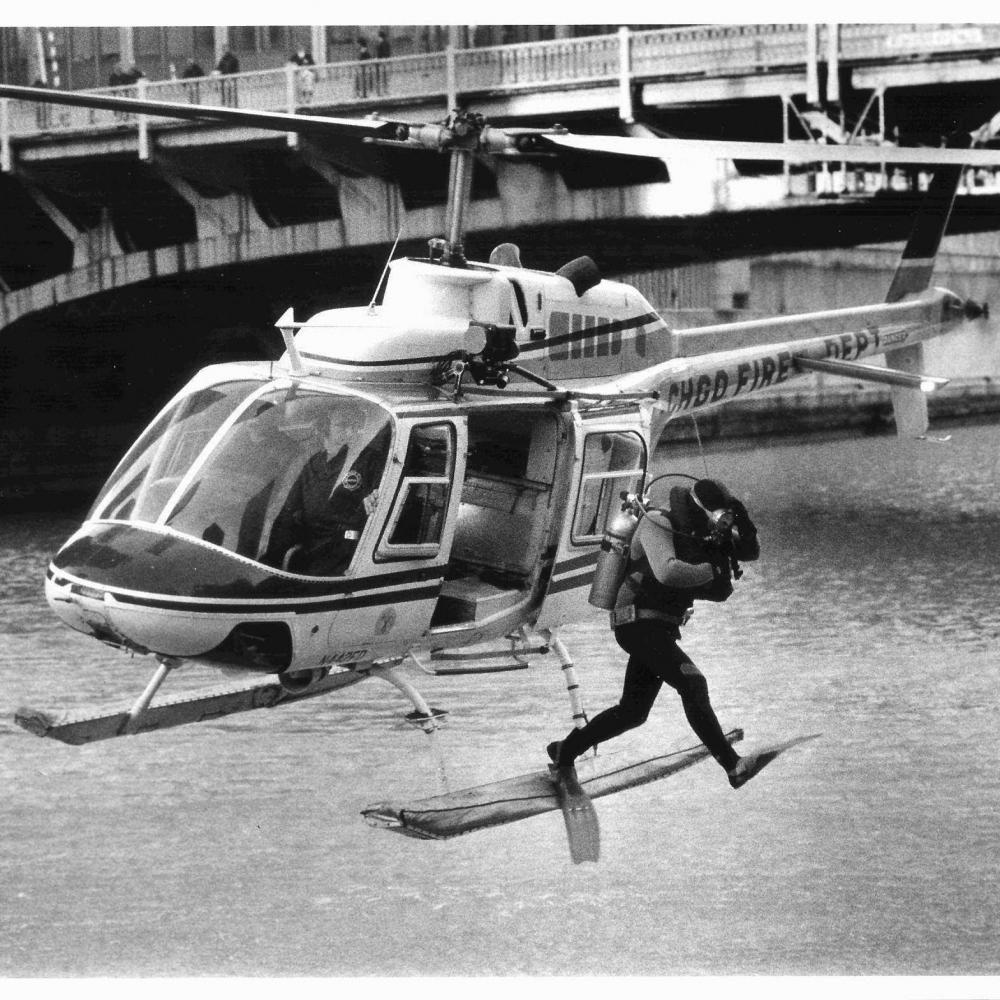Frog splash: diving in with the frogmen
Courtesy of the Chicago Fire Department
A member of the “Frogmen,” the Chicago FD dive team, jumps into water (above). Doug Carbol (next page), a 34-year-veteran of the dive team, said the team prepares in the water everyday.
May 22, 2017
Time was the biggest enemy but Doug Carbol, a 34-year-veteran for the Chicago Fire Department, knew that finding the victim in the dark freezing water of Lake Michigan in a matter of seconds would be a matter of life and death.
The Chicago Fire Department Helicopter Dive Team received a call for a car in Lake Michigan. When the rescue helicopter arrived on the scene, there were fishermen pointing 200 yards out from the break wall. Carbol dropped into the water.
“With four to five inches of visibility in front of me, I started my search. I didn’t have a location, somebody is just pointing.” Carbol said, “I just stopped for a moment and prayed, ‘help me find the car, Lord.’ Something told me to turn to my left and did one kick-bam- right into the tire of the car.” Carbol managed to get the woman out and onto shore, where she was revived.
For the Divers of the Chicago Fire Department, this is the norm. In order to be prepared for these calls the divers train in the water everyday.
All scuba divers are formally trained firefighters of the department. In order to become a part of the scuba team one needs to go through intensive water training and acquire many certifications. Training conditions include polluted water, black water and extreme ice conditions.
Carbol was among some of the first instructors, along with his father, Doug Carbol Sr. for the Chicago Fire Department Air Sea Rescue Team.
During the 1970s, Carbol remembered visiting his father at work, and watching the divers train. They typically performed drills along the lakefront. The divers wore a neoprene suit that allows the divers to stay warm for a short amount of time. As technology advanced, the team was introduced to dry suits. These suits allowed the divers to stay warm and dry as well as protected from hazardous water conditions. Full face masks were added to allow underwater communication diver-to-diver, diver-to-shore or diver-to-helicopter.
Carbol recalls several memorable moments on the job. One of these times was on Christmas Eve. Around 10 p.m., the rescue helicopter was dispatched to Wolf Lake, on Chicago’s southeast side for a car in the water. Upon arrival, the helicopter made several passes around the area to find the victims. Because of darkness and heavy blizzard conditions, visibility was limited.
They spotted a victim waving his hand above his head. Doug was deployed from the helicopter and was able to get a hold of the victim and put him in a horse collar (a harness used to secure people to be lifted out of the water by a helicopter). A second victim was spotted and placed on an inflatable raft. Both victims were brought to shore and survived.
Dangers on the job are extremely high. Carbol recalled the time he was trapped underwater in a tunnel at the Jardine Water Purification Plant, 1000 East Ohio St, which is one of the largest capacity water filtration plants in the world.
“The water was 32 degrees and there was no visibility,” Carbol said.
He was in the tunnel for almost 20 minutes.
“My first choice of course was to get out and not panic so that I could find my way back through the tunnel,” he added.
The dive suit that were used were so contaminated that they had to be thrown out.
The logo of the Scuba Team was originally designed by Carbol and his son Tyler which was later adopted by the the Chicago Fire Department as their official logo. The frog was inspired by the nickname divers were given, “Frogmen”.
An American flag and the city skyline were added after 9/11 by Carbol and fellow dive team member Chris Zon. T-shirts with their logo have become very popular and are sold through various firehouses and online.
Carbol’s love for the water and helping people inspired him to join the fire department. His advice for anyone interested in joining the dive team is to become an EMT and stay physically active.
“It’s a fantastic job” he said, “but one needs to be prepared to see blood, trauma and death.”
As far as Carbol is concerned, it’s the best job in the world.








